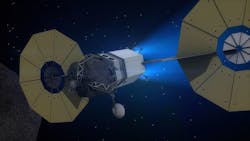Solar-electric propulsion for future deep-space missions is goal of NASA solicitation
Officials of the National Aeronautics and Space Administration (NASA) Jet Propulsion Laboratory (JPL) in Pasadena, Calif., released a solicitation Monday (DMS-2672-080416I) for the first phase of the Asteroid Redirect Robotic Mission Spacecraft (ARRMS) program.
The Asteroid Redirect Robotic Mission is part of NASAs plan for using cislunar space -- or the area between Earth and the moon -- as a proving ground for future human spaceflight beyond low-Earth orbit.
NASA scientists envision the ARRM as performing several demonstrations including the use of a 20-fold improvement in deep-space solar electric propulsion to move and maneuver large payloads; retrieve a boulder heavier than 20 tons from an asteroid and redirect it to a crew accessible orbit around the moon; and be a part of integrated crewed and robotic vehicle operations in deep space.
NASA officials would like to develop the solar-electric propulsion-based bus using commercially available U.S. industry capabilities and future plans.
Related: Deployable Space Systems, ATK Space Systems to develop NASA solar array system
Scientists are developing the ARRM spacecraft solar-electric propulsion in two phases: formulating a preliminary design with help from U.S.-only companies; and then developing the flight spacecraft bus.
For now, NASA scientists are interested only in the AARMS solar-electric propulsion preliminary design, in which several contractors may be involved. Actual funding will come in January 2016 after NASA receives its annual congressional appropriation.
The NASA Asteroid Redirect Mission will use robotic unmanned spacecraft technology to visit a large near-Earth asteroid, collect a multi-ton boulder from its surface, and redirect it into a stable orbit around the moon.
Once the big rock is there, astronauts will explore it and return with samples in the 2020s. This mission is part of NASA’s plan to advance the new technologies and spaceflight experience necessary for a human mission to the Martian system in the 2030s.
NASA officials say they plan to launch the robotic spacecraft at the end of this decade.
Companies interested in bidding for the Asteroid Redirect Robotic Mission Spacecraft deep-space solar electric propulsion preliminary design project must respond no later than 16 Nov. 2015. For the detailed solicitation companies must contact NASA's subcontracts manager, Deanna Smith, by email at [email protected], by phone at 818-354-2918, or by fax at 818-354-7536.
For additional questions or concerns contact NASA's contracting officer, Jim McKelvie, by email at [email protected], by phone at Phone 818-393-6952, or by fax at 818-393-2607.
More information is online at https://www.fbo.gov/spg/NASA/HQ/OPHQDC/DMS-2672-080416I/listing.html.
